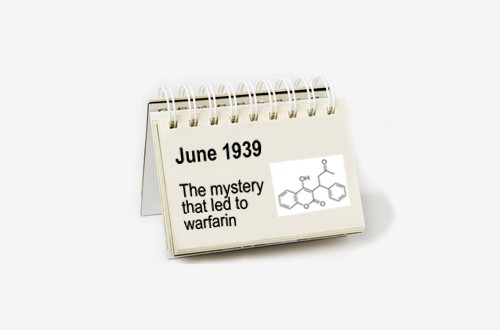
In the article ‘The Discovery of Dicumarol and Its Sequels’ for the American Heart Association journal Circulation, the chemist Dr Karl Paul Link describes his discovery of dicumarol – the substance that would lead to the development of warfarin – as a “kind of legend”.
Although not quite up there with Hercules and the Minotaur, it’s still a fairly accurate statement, considering the creation of the world’s most famous anticoagulant – allowing the treatment of life-threatening blood clots and atrial fibrillation – all began with a set of mysterious deaths that threatened the livelihood of farmers in the Northern US and Canada in the early 1920s.
Hundreds had cows that had succumbed to major haemorrhaging for what seemed to be no good reasons after undergoing a minor procedure, such as dehorning or castration, and farms from Alberta to Wisconsin felt the effect of herds of cattle that bled to death.
The mystery piqued the interest of Canadian veterinarian, Frank Schofield, who donned his deerstalker and magnifying glass for an investigation that determined all of the affected cattle had eaten mouldy silage made from a sweet clover plant.
This ‘sweet clover disease’ as it became known was only found in cows that had eaten hay that had gone off – a point proved in an experiment by Schofield who fed both good and damaged clover to rabbits, discovering that the unfortunate animal in the latter arm faced the same haemorrhaging effects as the cows.
It was another eight years, in 1929, before someone worked out just what this rotten clover actually did to the body of a cow (or rabbit), when fellow veterinarian Dr L M Roderick demonstrated that the affected animals lacked the blood clotting factor prothombin.
The actual substance in the vegetation that led to the lack of prothombin was still a mystery, however, with attempts by Roderick and others to extract the haemorrhagic agent proving unsuccessful.
Their work drew the attention of other researchers, however, including the already mentioned Wisconsin-based chemist Dr Karl Paul Link, who started his own investigation into the curious problem in 1933.
As described in his article for Circulation, Dr Link saw the very real effects of the disease’s impact on the local community when confronted by Wisconsin farmer Ed Carlson: “Late in December, he had lost two young heifers. In January, one of his favourite old cows had developed a massive haematoma on a thigh and following a skin puncture, fatal bleeding set in rapidly. Finally two young cows had died on Friday and the bull was oozing blood from the nose.”
All Dr Link could do at the time was explain to the farmer that his cows need to stop eating the affected clover, but he described the impact of the incident as “immense”.
The same sentiment could be applied to Dr Link’s senior student and research assistance Eurgen Wilheim Schoeffel, whose volatile, German-accented reaction Dr Link describes: “Vat vill he find ven he gets home? Sicker cows. And ven he and his good voman go to church tomorrow and pray and pray and pray, vat vill dey haf on Monday MORE DEAD COWS!! He has no udder hay to feed – he can’t buy any… Mein Gott!! Mein Gott!!”
Perhaps an exaggeration to prove a point from Dr Link, but nevertheless, this urgency turned into productivity, and he began experimenting with small animals to figure out the reason for the lack of prothombin.
It was a “long and arduous trail” as described by the doctor, but one that eventually reached an end as worthwhile as any mountain vista, when on June 28, 1939, Dr Link’s student Harold Campbell isolated the anticoagulant dicoumarol.
Large-scale extraction began almost immediately, while scientists confirmed that the dicoumarol was formed when coumarin – a molecule in many plants that produces the sweet smell of freshly cut grass – interacts with certain fungi, as in the case of rotten clover.
At the time, Dr Link’s work was supported by the Wisconsin Alumni Research Foundation (WARF), hence the decision to name a more potent molecule, synthesised from the coumarin-based anticoagulant, warfarin.
Its first approved use wasn’t as a medicine, however, instead being approved as a rat poison – a use it is still sold for (the delayed effect means rats don’t get put off by a mound of dead rat bodies around a more fast-effecting poison).
Safety concerns were the main issue behind its lack of use in humans, although these were eased in 1951 following the attempted suicide of man who overdosed on warfarin rat poison, but was successfully saved with doses of vitamin K – an important aspect in the synthesis of blood-clotting factor prothrombin.
With the knowledge its effects could be reversed, it wasn’t long before Endo Laboratories produced the first version of warfarin intended for humans under the trade name Coumadin, with the drug gaining widespread fame when it was used to help treat US President Dwight Eisenhower following a heart attack.
In the 60 years since then, warfarin has remained a staple part of a treatment for clotting conditions, helping in the treatment of countless people, while generics have been introduced from several major pharma firms.
A new generation of anticoagulants is now coming through, however, including Boehringer Ingelheim’s Pradaxa, Bayer’s Xarelto and Pfizer/ Bristol-Myers Squibb’s Eliquis, all of which are rapidly gaining approvals worldwide as a safer, simpler to administer alternative to warfarin.
These may overtake their predecessor as the main weapon in the treatment of blood clots, but warfarin’s discovery still stands as both one of the greatest medical breakthroughs of the 20th century and one of its great detective stories.





